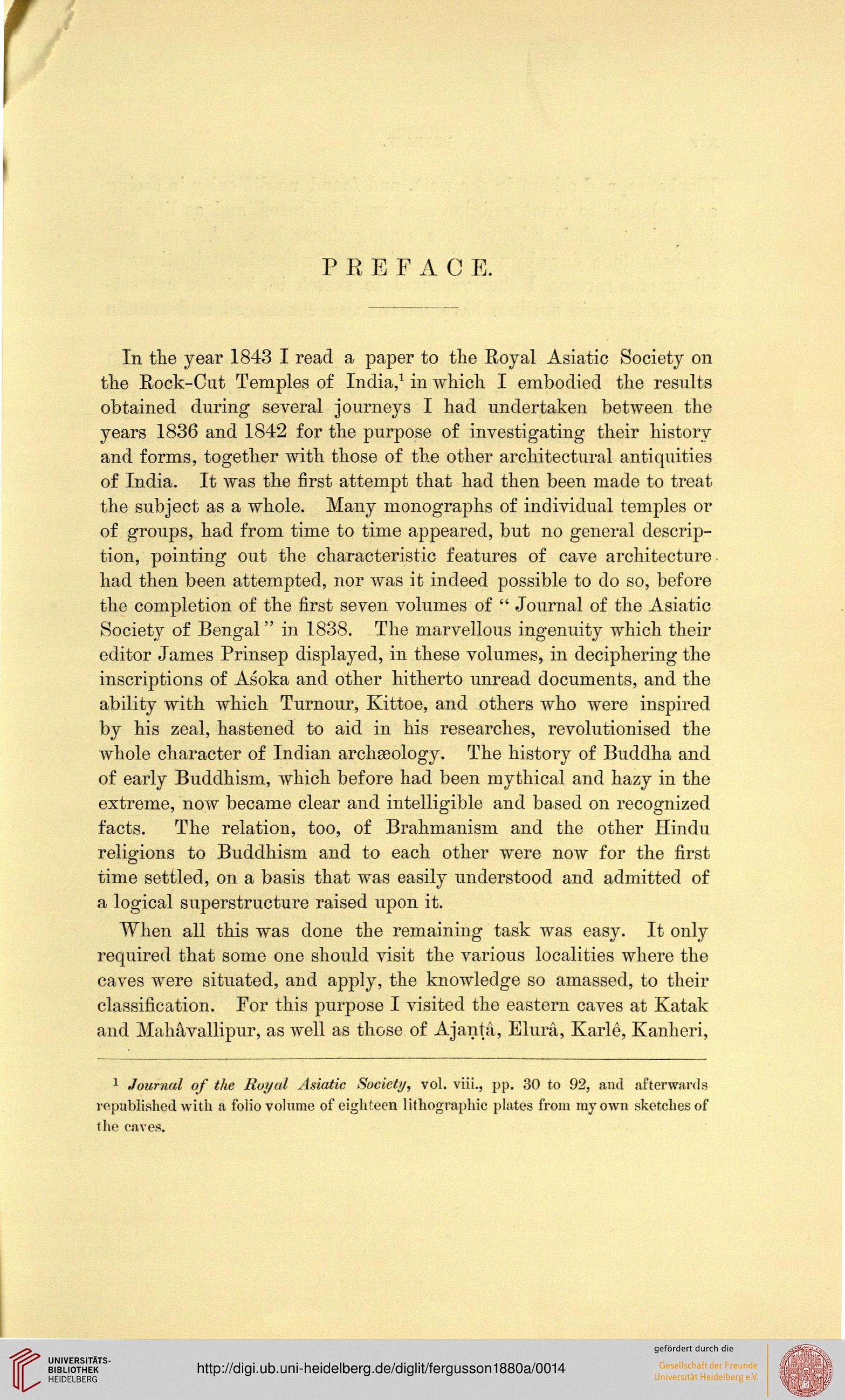P R E F A 0 E.
In the year 1843 I read a paper to the Boyal Asiatic Society on
the Bock-Cut Temples of India,1 in which I embodied the results
obtained during several journeys I had undertaken between the
years 1836 and 1842 for the purpose of investigating their history
and forms, together with those of the other architectural antiquities
of India. It was the first attempt that had then been made to treat
the subject as a whole. Many monographs of individual temples or
of groups, had from time to time appeared, but no general descrip-
tion, pointing out the characteristic features of cave architecture
had then been attempted, nor was it indeed possible to do so, before
the completion of the first seven volumes of " Journal of the Asiatic
Society of Bengal" in 1838. The marvellous ingenuity which their
editor James Prinsep displayed, in these volumes, in deciphering the
inscriptions of Asoka and other hitherto unread documents, and the
ability with which Tumour, Kittoe, and others who were inspired
by his zeal, hastened to aid in his researches, revolutionised the
whole character of Indian archaeology. The history of Buddha and
of early Buddhism, which before had been mythical and hazy in the
extreme, now became clear and intelligible and based on recognized
facts. The relation, too, of Brahmanism and the other Hindu
religions to Buddhism and to each other were now for the first
time settled, on a basis that was easily understood and admitted of
a logical superstructure raised upon it.
When all this was done the remaining task was easy. It only
required that some one should visit the various localities where the
caves were situated, and apply, the knowledge so amassed, to their
classification. For this purpose I visited the eastern caves at Katak
and Mahavallipur, as well as those of Ajanta, Elura, Karle, Kanheri,
1 Journal of the Royal Asiatic Society, vol. viii., pp. 30 to 92, and afterwards
republished with a folio volume of eighteen lithographic plates from my own sketches of
the caves.
In the year 1843 I read a paper to the Boyal Asiatic Society on
the Bock-Cut Temples of India,1 in which I embodied the results
obtained during several journeys I had undertaken between the
years 1836 and 1842 for the purpose of investigating their history
and forms, together with those of the other architectural antiquities
of India. It was the first attempt that had then been made to treat
the subject as a whole. Many monographs of individual temples or
of groups, had from time to time appeared, but no general descrip-
tion, pointing out the characteristic features of cave architecture
had then been attempted, nor was it indeed possible to do so, before
the completion of the first seven volumes of " Journal of the Asiatic
Society of Bengal" in 1838. The marvellous ingenuity which their
editor James Prinsep displayed, in these volumes, in deciphering the
inscriptions of Asoka and other hitherto unread documents, and the
ability with which Tumour, Kittoe, and others who were inspired
by his zeal, hastened to aid in his researches, revolutionised the
whole character of Indian archaeology. The history of Buddha and
of early Buddhism, which before had been mythical and hazy in the
extreme, now became clear and intelligible and based on recognized
facts. The relation, too, of Brahmanism and the other Hindu
religions to Buddhism and to each other were now for the first
time settled, on a basis that was easily understood and admitted of
a logical superstructure raised upon it.
When all this was done the remaining task was easy. It only
required that some one should visit the various localities where the
caves were situated, and apply, the knowledge so amassed, to their
classification. For this purpose I visited the eastern caves at Katak
and Mahavallipur, as well as those of Ajanta, Elura, Karle, Kanheri,
1 Journal of the Royal Asiatic Society, vol. viii., pp. 30 to 92, and afterwards
republished with a folio volume of eighteen lithographic plates from my own sketches of
the caves.





